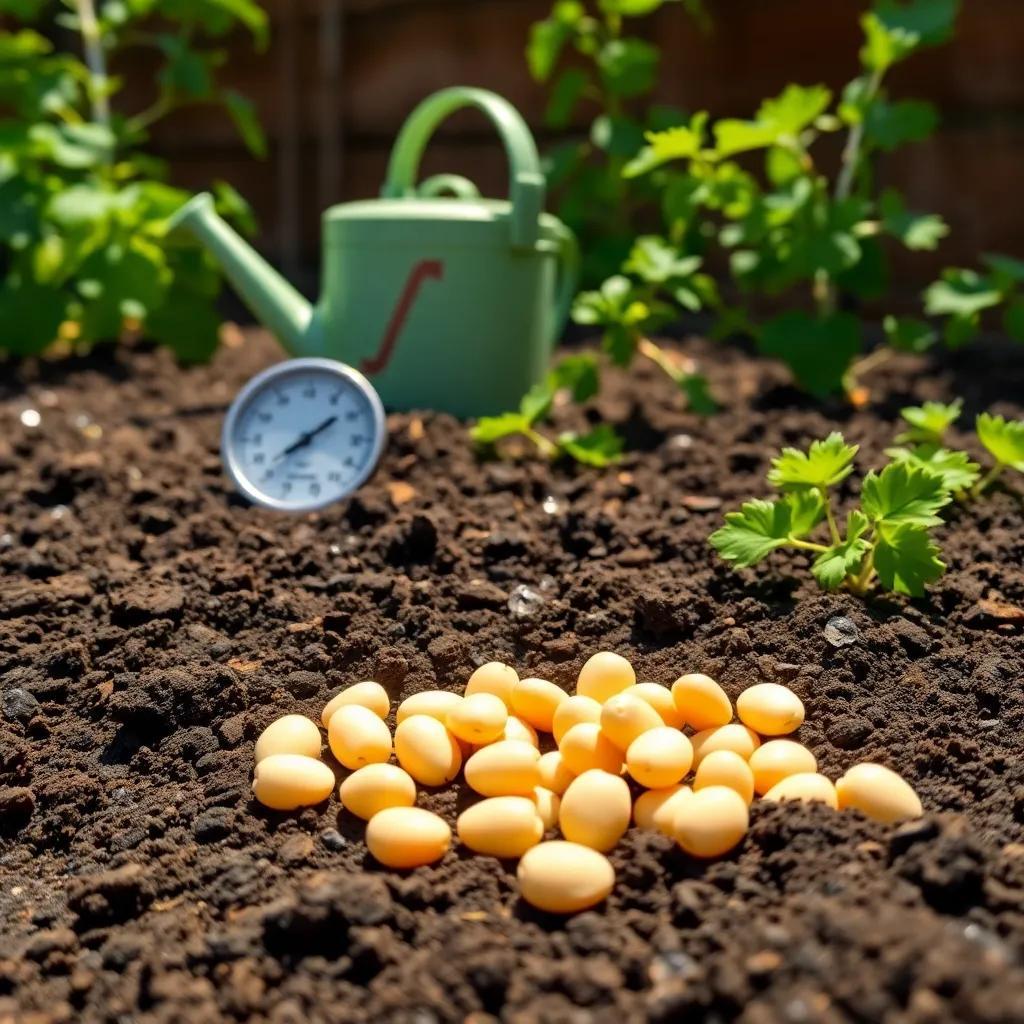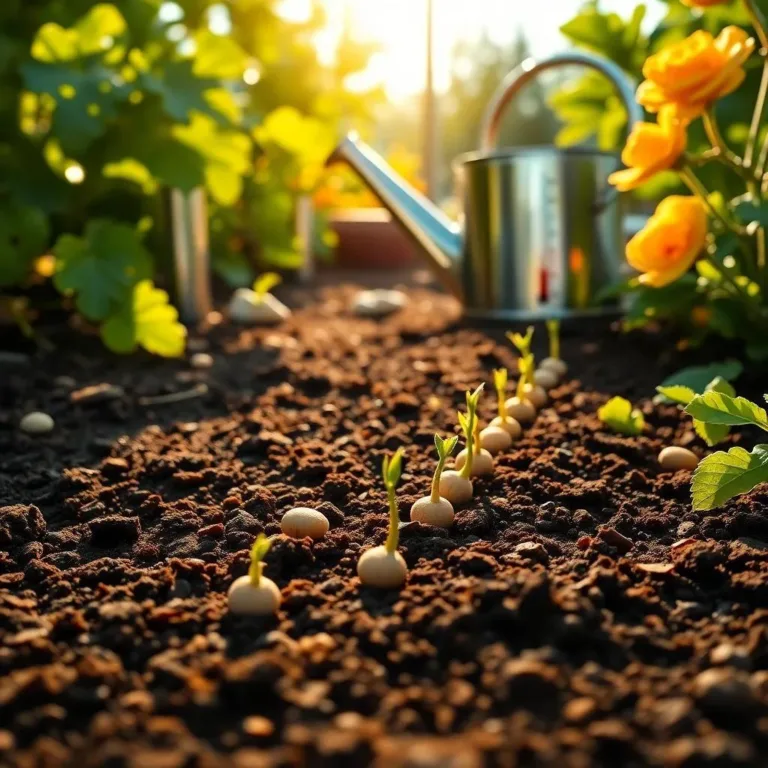Are you ready to grow your own delicious cantaloupes? I’m excited to share everything I’ve learned about how to get those seeds sprouting and thriving! From ideal conditions to tackling common issues, join me on this fruity adventure and let’s make our gardens blossom with sweet, juicy melons!
Factors Influencing Cantaloupe Germination Rates
When it comes to growing cantaloupe, several factors can really make a difference in how quickly those seeds sprout. Getting to know these influences will help me create an amazing garden filled with delicious melons! Let’s break it down:
- Temperature: Cantaloupe seeds love warm weather! Ideally, they want the soil temperature to be between 70°F and 85°F (21°C to 29°C). If it’s too cold, the seeds might just sit there, thinking about what to do next. To kickstart the process, I can use a soil thermometer to check the warmth. Who knew gardening could involve a science experiment?
- Moisture Levels: Water is a seed’s best friend. Keeping the soil moist, but not soaking wet, is key. If the dirt is too dry, the seeds could get cranky and refuse to germinate. If it’s too wet, they’re likely to rot. A good routine is to check the moisture every day—my goal is a balanced, happy seed bed!
- Soil Quality: Cantaloupes are picky when it comes to their living conditions. They prefer well-draining soil that’s rich in organic matter. Mixing in some compost or aged manure can make a huge difference. It’s like giving my plants a delicious buffet!
- Seed Quality: Starting with good seeds is a no-brainer. I want to pick fresh, plump seeds that are stored properly. Old or damaged seeds can lead to a sad garden. I can save myself some disappointment by checking for quality!
By keeping these factors in mind, I can maximize my chances for successful germination and get those juicy cantaloupes growing quickly! What could be better than that?
Ideal Conditions for Cantaloupe Seed Germination
Creating the perfect environment for cantaloupe seeds is like setting the stage for a blockbuster movie! I want everything just right to help those seeds thrive and turn into lush plants. Here’s how I can achieve those ideal conditions!
- Soil Preparation: I’ll start with a soil that’s not only well-draining but also packed with nutrients. Mixing in compost or using a loamy soil mix gives seeds a cozy home! Before planting, I’ll break up any big clumps in the dirt to ensure good airflow. Nobody likes a cramped apartment, right?
- Temperature Monitoring: Keeping the soil in that sweet spot of 70°F to 85°F is essential. Using a heat mat can help give my seeds the warmth they crave. Imagine them basking in the sun like beachgoers—happy and ready to grow!
- Watering Wisely: I’ll check soil moisture each day, watering gently to avoid washing the seeds away. A fine mist or light sprinkle works wonders. My goal is to keep the soil consistently moist, which makes my seeds smile!
- Sunshine: Once my little sprouts poke through the soil, they’re going to need 6 to 8 hours of direct sunlight daily. I’ll choose a sunny spot in my garden where they can soak up the rays. If they’re indoors, some grow lights can really help.
By giving my cantaloupe seeds these ideal conditions, I’m setting myself up for a fruitful season! I can almost taste the sweetness of my homegrown melons, and I can’t wait to share them with friends and family!

Common Germination Issues and Solutions
Even the best gardeners face challenges, and germinating cantaloupe seeds can sometimes be tricky! But don’t fret; I’ve gathered some of the most common problems and how I handle them. Let’s roll up our sleeves and tackle these issues together!
- Poor Germination Rates: This can happen for several reasons. If I notice my seeds aren’t sprouting, I start by checking the seed quality. Using fresh seeds can make a big difference! Also, I make sure I’m planting them at the correct depth—about 1 inch deep works wonders. If the temperature or moisture is off, I adjust those too!
- Seed Rot or Damping-Off: This pesky problem occurs when the soil is too wet. If I see my seedlings collapsing, I know it’s time to improve drainage! I allow the soil to dry out a bit and make sure air circulates around my plants. Using sterilized seed-starting mix can help keep bacteria at bay!
- Leggy Seedlings: If my seedlings are stretching toward the light, they’re telling me they need more sunshine! I ensure they get at least 6-8 hours of light daily. If I’m growing indoors, moving them closer to a window or using grow lights does the trick!
By being attentive and recognizing these issues early, I’m on the path to a successful cantaloupe crop! Gardening is all about learning and adjusting, and with a little patience, I can overcome these common hurdles!
Tips for Faster Cantaloupe Seed Germination
I always want my cantaloupe seeds to sprout quickly, so I’ve picked up some handy tips that really help speed up the germination process! Here’s my go-to list for making those seeds pop up and grow!
- Pre-soak the Seeds: Soaking cantaloupe seeds in warm water for about 24 hours before planting can give them a head start! This softens their seed coats, making it easier for them to absorb moisture and sprout faster.
- Start Indoors: If I live in a cooler climate, I often start my seeds indoors. Using biodegradable pots filled with seed-starting mix gives my seeds a warm, cozy home. I can control the conditions and then transplant them outside once they’re ready!
- Use Bottom Heat: A seedling heat mat can be a game-changer. By providing consistent warmth from below, my seeds germinate faster. It’s like giving them a warm hug!
- Maintain Moisture Levels: Gently misting the soil helps keep it moist without drowning the seeds. I pay close attention so they’re not too dry or too wet!
- Protect from Cold: If I’m planting outdoors, I wait until the danger of frost is gone, but if a cold snap threatens my little sprouts, I use row covers or cloches to keep them cozy!
With these little tricks up my gardening sleeve, I’m ready to see my cantaloupe seeds shoot up before I know it! Can you imagine biting into a sweet, juicy melon from seeds I nurtured myself? Yum!
Gardening FAQs about Cantaloupe Germination
As I dive deeper into growing cantaloupe, I’ve picked up a lot of questions along the way! Here are some frequently asked questions that I think are super helpful for anyone wanting to grow their own melons!
Q: How long do cantaloupe seeds take to germinate?
A: Typically, I find that cantaloupe seeds can sprout in about 7 to 14 days under perfect conditions. Sometimes they might take a bit longer, especially if the weather isn’t cooperating.
Q: What’s the best way to plant cantaloupe seeds?
A: I like to sow them directly into the soil about 1 inch deep after the last frost. Keeping them spaced around 18-24 inches apart gives them room to grow!
Q: How often should I water cantaloupe seeds during germination?
A: It’s best to keep the soil consistently moist. I usually water gently every day, especially if it’s dry outside. Just avoid creating a puddle!
Q: What temperature is ideal for germination?
A: Cantaloupe seeds love warmer temps! I’ve found that a soil temperature between 75°F and 85°F (around 24°C to 29°C) is perfect for helping them sprout quickly.
Q: How can I help my cantaloupe seeds germinate faster?
A: Covering the planting area with a clear plastic sheet can create a mini greenhouse effect, trapping heat and moisture. Just remember to remove the plastic once the seeds sprout!
With these tips and answers to common questions, I feel confident to tackle my cantaloupe-growing journey! Happy gardening!

